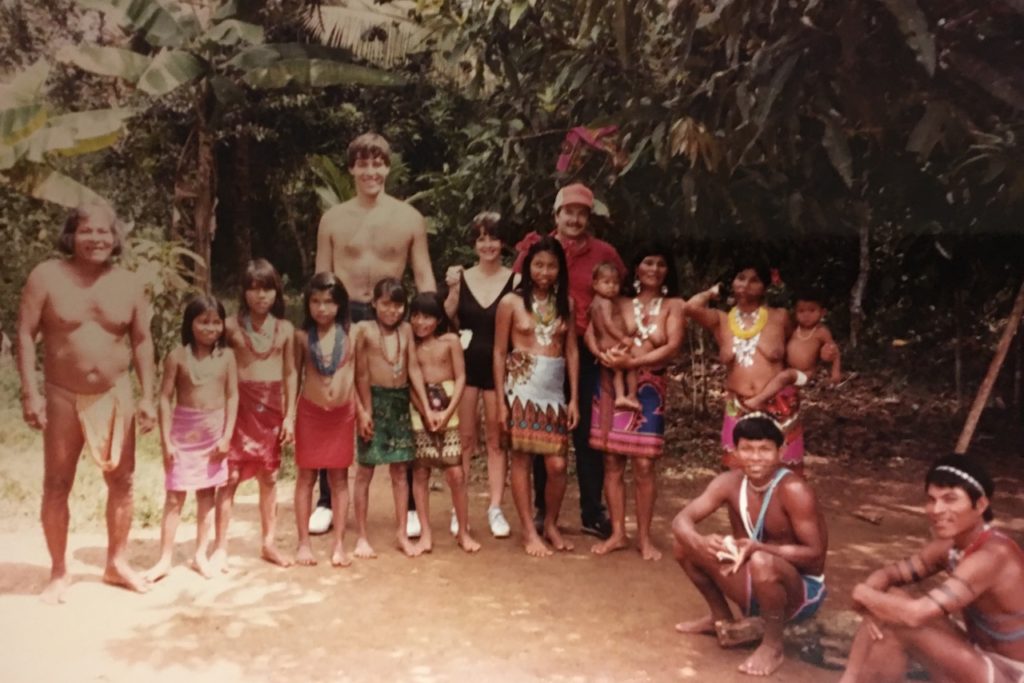 Musings
Musings  No Comments
No Comments The Treasure Cave Theory of Leadership
In the mid-80’s, I was a contractor to the US government in the former Panama Canal Zone. I had hundreds of local employees. Among them were half-dozen Embera Choco Indian tribesmen who hailed from the foreboding Darien jungle. The Darien, connecting Panama and Columbia, was virtually impenetrable and was the only stretch of land between the northern tip of Alaska and the southern tip of Chile where the Inter-American Highway was not connected.
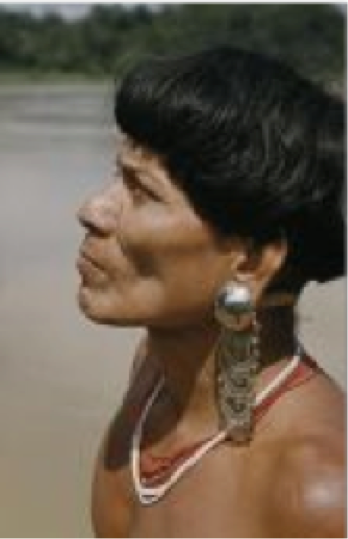
The father of these ‘Indios’ was a Choco Cacique (Chief) and also a Brujo (Witch-Doctor) of their village. The Chief visited me on several occasions bringing stories of gold and ancient Spanish treasures that he had discovered near his very small jungle village. The Cacique told me of finding a secret cave within which he uncovered a large wooden door. Behind the door he found a six-foot long alligator statue made of gold and many Spanish Conquistador helmets.
Remember in the 1500’s, the Spanish Conquistadors, which plundered Inca gold and treasures from Peru, traversed the land bridge of Panama exiting on the Caribbean coast to board their ships for return voyages to Spain.
My interest and thoughts of adventure and riches spiked.
The Cacique said that he would guide me to his cave and share his findings. He asked me to bring provisions to his village of 40 people; shotgun and .22 shells, matches, rice, beans, coffee, beer, cigarettes—and bolts of red tela (cloth).
The Cacique cautioned that the area surrounding the cave was patrolled by dangerous ‘devil dogs’. The tela would be used to safely cordon off the cave, as the devil dogs feared the bright red cloth.
Within two weeks I had convinced several equally excited friends to join me in this treasure reclaiming expedition.
At 05:00 on a Saturday morning we left Panama City with a convoy of two of my large flatbed trucks and two 4-wheel drive vehicles. The journey to the end of the paved road to the beginning of the Darien was to take only three hours.
Not so! Mechanical failures and multiple tire blowouts delayed our arrival to 18:00. Near the equator, in the jungle, at 6:00 PM darkness is ‘at hand’.
The planned Choco bearers who were to help carry all the provisions and gear to the village had long ago decided that we were ‘No-Shows’ and had left for their village. This meant that the five Gringos, my friends, and me had to carry all the gear.
The Darien jungle is not a welcoming place for the inexperienced trekker.

At night it is a black scary a place.
Barely able to see three feet in front, each burdened with more than 50 lbs. of gear, my team stumbled blindly through the jungle while we fearfully followed the sole Choco guide for over three hours – that felt more like three days. If there was a path we couldn’t see it. An unspoken rule was not to mention the deadly snakes, crocs, or wild boar that lived in the jungle.
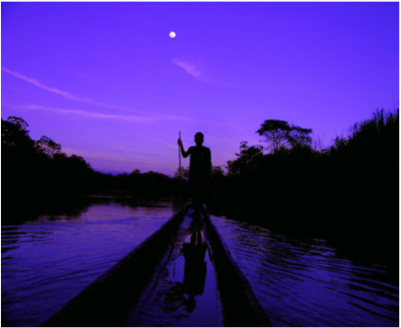
Finally we broke out of the jungle onto a riverbank. Three 20- foot cayucos (dug- out canoes) were waiting for us. Loading and boarding the narrow cayucos required balance and caution. Each dugout was piloted by a Choco whose only propulsion was a long pole. My team and I did not want to know what kind of river-life threatened us from below.
Two hours later, exhausted, we disembarked on a small beach at the entrance to the Cacique’s village. Dragging all the gear up the slope to the village our only aim was to collapse in whatever fashion of beds were available.
Not to be! The Cacique and a few elders had prepared a welcoming ceremony. Due to the very late time he immediately began. My team and I sat on the floor of the Cacique’s raised hut while he began chanting to honor us and bless the expedition. The chanting, accompanied by the elders’ drumming, lasted two hours – it felt like two days!
My attempt to meditate to the chanting was really more dozing, on and off. Each dozing would lead to full-colored fanciful dreams.
After less than four hours of restless sleep rude roosters brazenly crowed a wake-up call, “No choice. Get-up!” Still exhausted we surveyed our surroundings in the daylight.
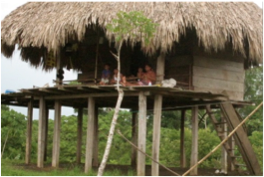
The village consisted of a dozen thatched-roofed, open-sided huts built on stilts. The huts were raised about 10 feet in the air to provide safety from roaming predators and floods.
After a simple breakfast of fertilized eggs and yucca, aided by some gear-carrying villagers, including bare-breasted teenage girls, we formed single-file and set off hiking through the jungle.
Our hike, steamy hot in daylight, was punctuated with annoying attacks of all sorts of flying insects, leeches, and other creepy crawlers. After 1-1/2 hours we arrived at a small clearing in the center of which was a 10 feet deep pit about 20 feet around. The Cacique pointed to a small opening on the other side of the pit and exclaimed, “Aqui estamos!” – “We are here!”, or something like that in his native language signaling that this was the site of the treasure cave.
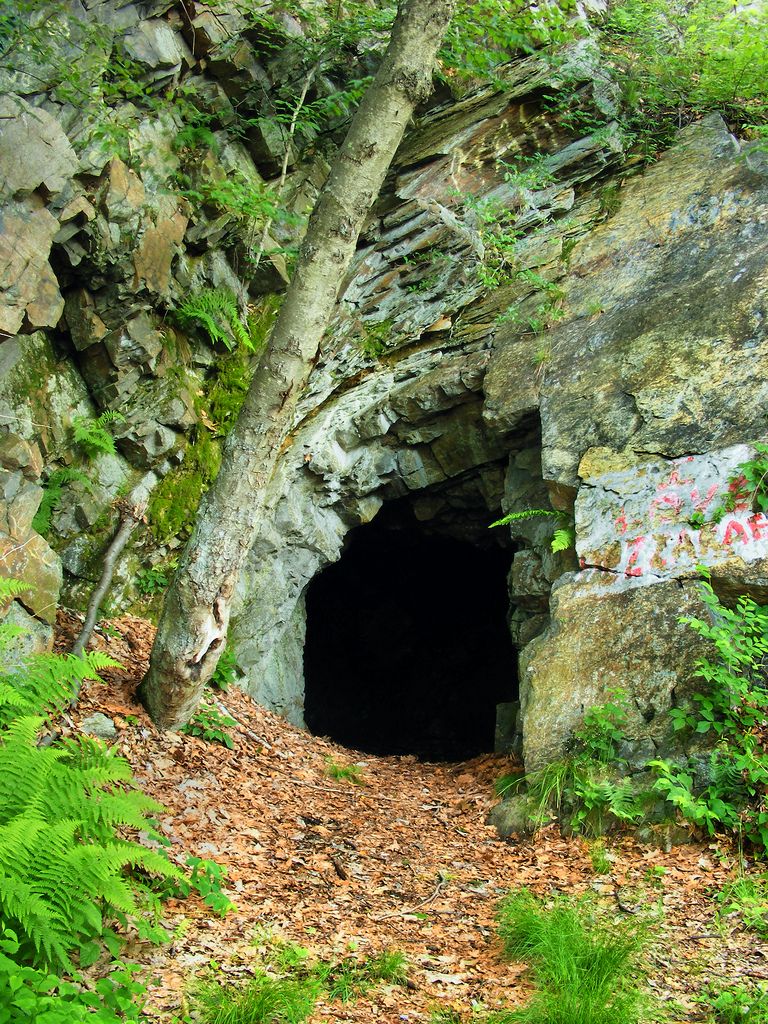
My friends and I jumped in the pit and peered into the opening. With our flashlights we could see that the three-foot wide and tall entrance opened into a cavern with a five-foot ceiling and an indeterminable depth. Our lights also revealed that the cave ceiling was crowded with thousands of hanging bats – the floor with inches of bat droppings. The ammonia smell was nearly over-powering.
The Cacique handed us shovels and invited us to enter the cave. Some of my team members balked. No braver than the rest but compelled as the expedition financier and organizer I crawled, shovel in hand, through the entrance. A son of the Chief accompanied me and told me to start digging on the far earthen cave wall. So I did. The bats didn’t like my presence any more than I did theirs and they made it known by swooping and darting down at me. As the cave ceiling was only five feet high I had to dig while crouching on my knees trying not to touch or be touched by the bats.
Every 30 minute or so I would exit the cave for a rest and invite others to share in the digging. No takers…
After many hours of digging, finding only more dirt I exited the cave and asked the Cacique where the large wooden door was. In his language he made a lengthy reply gesturing wildly. I patiently waited for the fractured translation from Choco to Spanish to English.
Poof! That’s how epiphanies happen! Mine was when I finally understood that the large wooden door, the golden alligator, and the Conquistador helmets were all seen by the Cacique/Brujo in a ‘Vision’!
I am certain that the untold part of his vision included rifle shells, rice, beans, coffee, beer, cigarettes – and tela!
What is the lesson here?
An effective leader always works to understand the needs and wants of people feeding him information – knowing this will affect the ‘What, Where, Why, and How’ of the info provided and that the intentions and goals may not be in mutual alignment. Effective leaders do not let their personal exuberance cloud their judgment when developing or executing plans.
I would tell this long story to my managers and supervisors mentoring them to exercise diligence in assessing the needs, wants, and motivations of our suppliers and even our clients – working for alignment before finalizing or implementing deliverables.
What possible activities in your personal or professional life might be succumbing to not practicing the lessons of The Treasure Cave Theory of Leadership?
Name three. What reassessed actions are you going to take?
***
Never waste an experience of extreme stress, ego-wrenching embarrassment, or personal injury without learning from it. – Dad
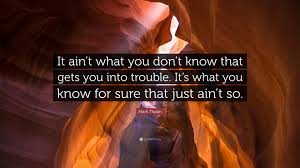
(PS – After Tony Robbins presented his seminars in Panama (see ‘Integrity is the Key’ –in Musings) we took him to the Darien to meet Cacique Mezua. This was a special adventure for Tony and the Indios,?
